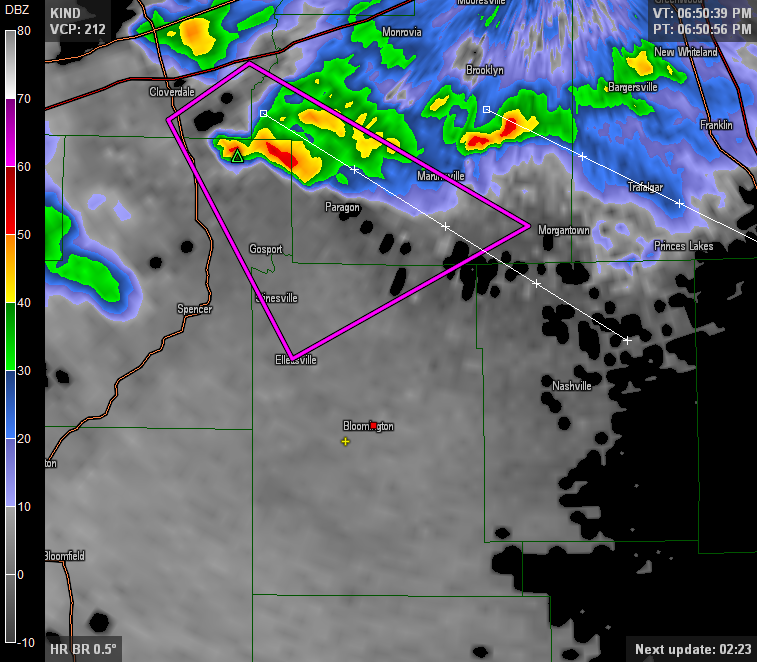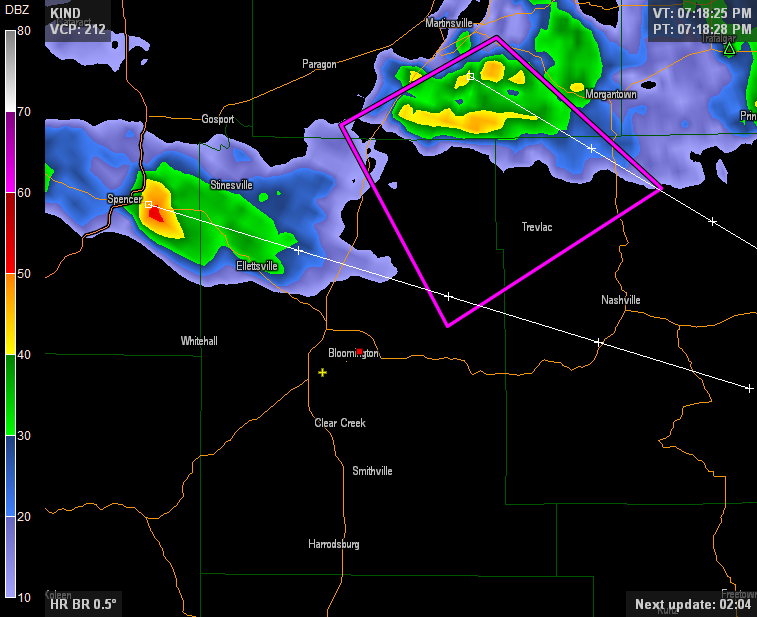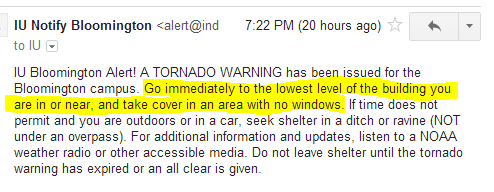TL;DR version: Sirens go off if any part of the county is put under a warning, even if the risk is nowhere near your part of the county. YOU may not even be at risk.
Last night in Bloomington was a textbook case of how complicated the “weather warning business” really is. Here’s a rundown of the most important issues.
Warnings. Since 2007, the National Weather Service has issued tornado warnings not by county but by risk area–it’s called a “polygon” because, well, it looks like one:
The area in that pink box is the area the experts at NWS in Indianapolis placed under a tornado warning, for the storm that’s also in the box (this is a pretty standard weather radar image that you’d see on tv, with red indicating heavy rain and hail and the small green triangle also an indicator of hail). This image is of the first tornado warning from last night. Notice how this box does not include any part of downtown Bloomington, or the heart of the IU campus (red dot), or even my house (yellow plus). This polygon is the box I use to make my own safety decisions. Any weather app that’s worth its salt will plot these polygons. Look at that image again. For the entire time the warning was in effect, NWS predicted that the storm would remain in that box (and it did). There is no reason to panic or to take shelter if you’re not in the path of the storm–which is what the box shows for this warning.
As the NWS office in Birmingham, Alabama says: “It is our goal that only those inside the polygon should take action.”
Sirens. Many siren systems in the US are still sounded by county. That means that no matter how small the sliver of your county, if any part of the county is placed under a tornado warning, the sirens will go off everywhere. This is true in Monroe County–it happened twice last night. So the takeaway messages are:
- Sirens do NOT always imply that your location is in danger. They imply that some PART of your county is in danger. The storm may stay 10, 20, or even 30 miles away from you.
- Sirens are sounded by a county employee (at least here). No one on the IU campus, to my knowledge, has any control over the sirens. None.
By the way, the sirens went off twice in Bloomington last night. The second time was for a storm that was forecast to clip the northeastern part of Monroe County. Here’s the radar and tornado warning polygon for the second one:
Again, no risk for Bloomington. Zero, zilch, nada.
Confusion. Last night got a little squirrely because IU sent messages telling everyone to seek shelter for the first warning, but for the second warning, some messages told people that campus was not being impacted. For once, the polygon seemed to matter! This should happen in every event. This should become the standard and not the exception. (For the record, it’s the first time in my 3 years of living here that I’ve seen this happen.)
Here’s what we absolutely cannot do. Send this email:
And then send this tweet:
This is a messaging and safety nightmare. Why would I “take cover” for something that “does not impact” me? Which one of these messages should people listen to, if either one? Just as mixed messages from faculty to students lead to protests and grade changes, mixed weather information leads to fatalities. This storm was of absolutely no risk to Bloomington, but the message implied it was. Until it wasn’t.
My personal view is that we all have to make our own safety decisions. I realize that if you live in a residence hall, or work at a big-box store, you may be required to follow someone else’s instructions. Based on the above, I’m honestly not sure what those instructions would have been. With that in mind, I’ve always believed and said that you and you alone are responsible for your safety. Make the decisions you need to make and do what you have to do, whatever that may be. That goes both for both seeking shelter and coming out from shelter so you can get on with your life.



